Games PC COMBAT FLIGHT SIMULATOR 3-MACHINES OF WAR User Manual
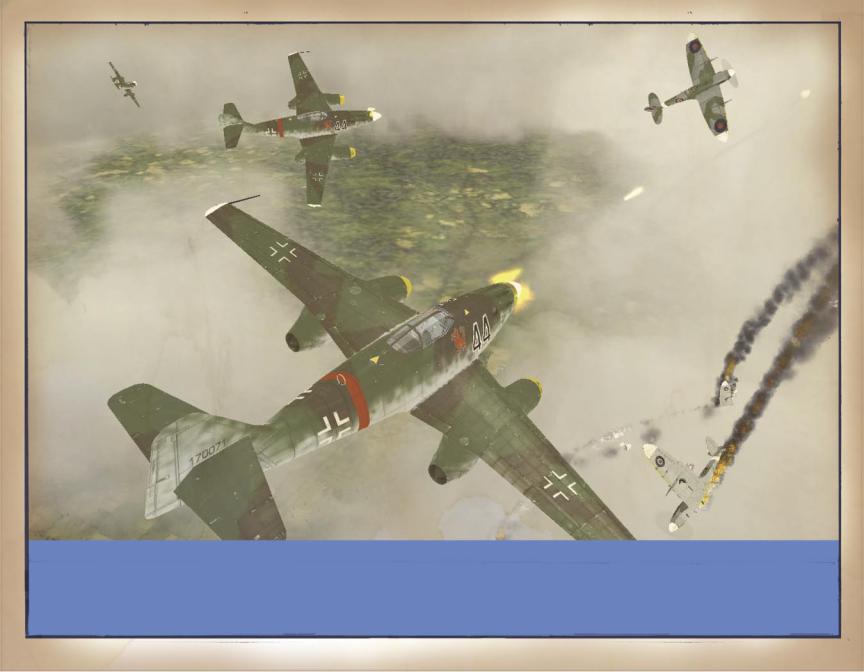
Microsoft® Combat Flight Simulator 3.0
MACHINES OF WAR
handbook
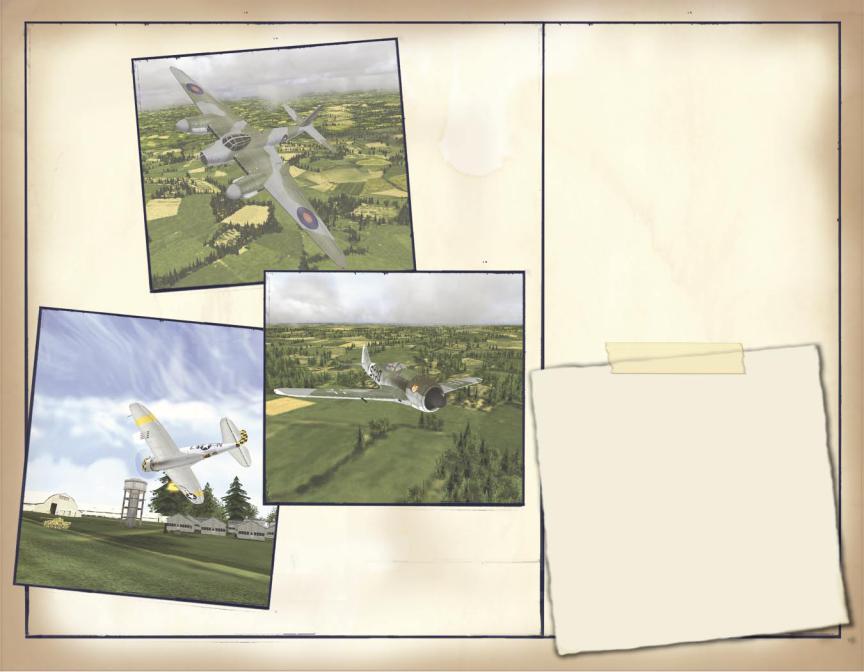
Subject: CONTENTS
Authorized licensees of this game may print (or have printed at their expense) a single copy of this manual for their personal home use in conjunction with the play and use of the game on this CD.
CONTENTS |
|
Aircraft |
|
U.S. aircraft .................. |
3 |
British aircraft .............. |
14 |
German aircraft ............... |
23 |
Vehicles and Weapons |
|
Vehicles ...................... |
35 |
Weapons ....................... |
43 |
Ships ......................... |
45 |
Aircraft Armaments |
|
Rifle-caliber machine guns ..... |
48 |
Heavy machine guns ............ |
49 |
Automatic cannon .............. |
50 |
Heavy cannon .................. |
52 |
Torpedoes ..................... |
53 |
Rockets ....................... |
54 |
The Aircraft |
of CFS3 |
|
|
|
You’ve |
got |
|||||||||||||||
|
|
|
|
PILOT: |
|||||||||||||||||
|
|
|
|
|
|
|
TO THE |
|
|||||||||||||
A NOTE |
|
but you |
|||||||||||||||||||
|
|
|
|
|
|
of you, |
|||||||||||||||
|
|
|
|
job ahead |
|
|
|
|
|
each |
|||||||||||
a tough |
|
|
plane for |
||||||||||||||||||
|
|
|
the right |
|
|
||||||||||||||||
can select |
|
|
|
|
|
stable |
|||||||||||||||
|
|
|
|
impressive |
|||||||||||||||||
mission |
from an |
|
from a |
||||||||||||||||||
|
can |
choose |
|||||||||||||||||||
|
|
|
. |
|
You |
including |
|||||||||||||||
|
|
|
|
|
|
|
|
|
|
|
|
|
|||||||||
of aircraft |
|
|
|
-seaters, |
|
||||||||||||||||
variety |
of |
single |
-propeller |
|
fighters |
||||||||||||||||
|
|
|
|
|
|
|
|
|
|
-and |
|
|
|
|
|
|
- |
|
|||
|
|
hot |
piston |
|
|
|
|
|
|
|
|
|
|||||||||
some |
|
|
|
|
|
|
the minute |
jet |
|
|
|||||||||||
|
|
|
|
|
|
|
|
to- |
|
|
|
|
|
|
|
-engine |
|||||
and |
some up- |
. |
|
|
|
|
|
|
|
||||||||||||
|
|
|
|
|
|
|
|
Need a twin |
|
|
Take |
||||||||||
propelled |
|
jobs |
|
the |
job done? |
|
|||||||||||||||
to |
|
get |
|
|
|||||||||||||||||
aircraft |
|
|
|
|
on, |
|
aviation |
||||||||||||||
|
. |
With |
a war |
|
|
||||||||||||||||
|
|
|
|
|
|
|
|
|
. Here’s |
||||||||||||
your |
|
pick |
|
|
|
|
|
|
|
|
|
|
|||||||||
|
|
|
|
|
|
is moving |
fast |
|
|
|
|
||||||||||
technology |
|
best planes |
|||||||||||||||||||
|
to |
fly the |
|||||||||||||||||||
your |
chance |
|
|
|
|
|
|
|
|||||||||||||
|
. |
|
|
|
|
|
|
|
|
|
|
||||||||||
|
|
|
|
|
|
|
|
|
|
|
|
|
|
|
|
|
|||||
|
|
|
|
|
|
|
|
|
|
|
|
|
|
|
|
|
|
|
|
||
in the arsenal |
|
|
|
|
|
|
|
|
|
|
|
||||||||||
- 2 -
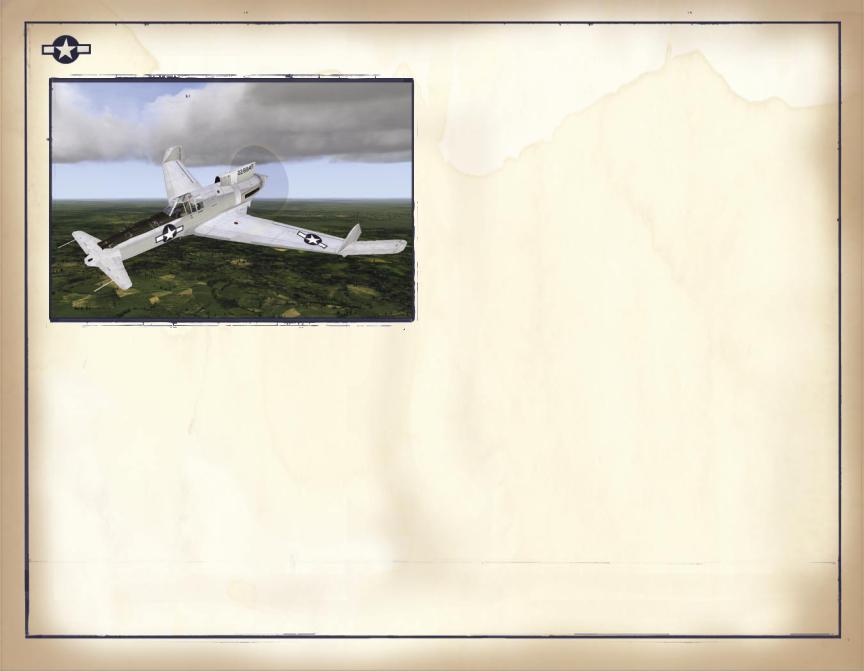
Subject: U.S. AIRCRAFT
Curtiss P-55 Ascender
This futuristic bird’s swept wing, canard eleva- P-55 tors, rear engine, and pusher propeller gave it a
look like no other fighter. However, the experimental 24-cylinder liquid-cooled flat-H engine originally intended for the Ascender never reached production. Its 2,200 horsepower might have provided a top speed over 500 mph. The Allison V-12 that replaced the proposed Pratt & Whitney engine reduced the plane’s performance from stellar to average. Low-speed handling problems, including a vicious stall with little or no warning, were partially addressed by modifications to the prototype’s wings and vertical surfaces, but with jet aircraft already under development, the Ascender project was abandoned after the third prototype. For a fascinating “what-if” scenario and a unique piloting experience, try the Ascender as it might have been, with 75 percent more power and improved handling.
- 3 -
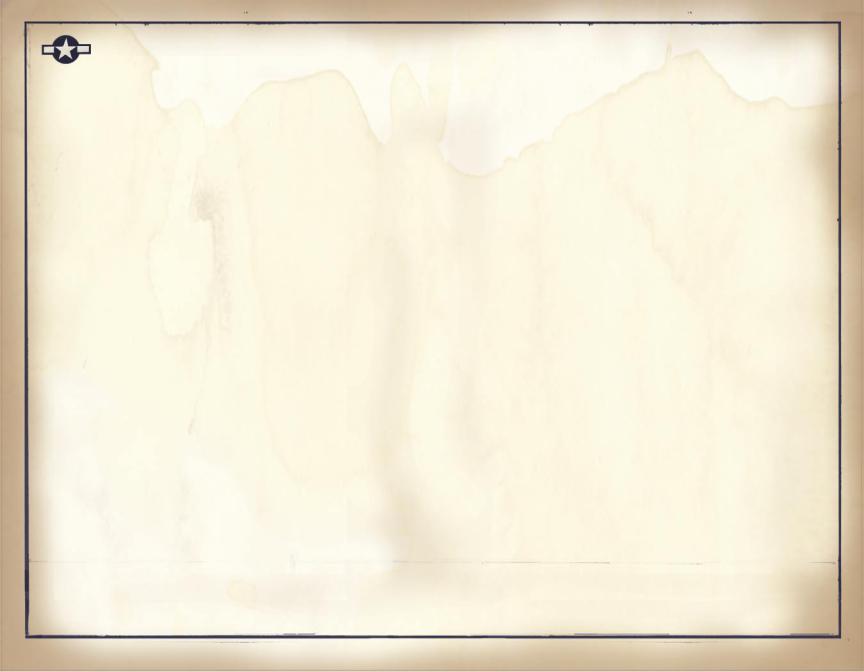
Subject: U.S. AIRCRAFT
P-55 SPECIFICATIONS |
XP-55 SPECIFICATIONS |
(the aircraft in CFS3, as originally designed) WEIGHT: 6,354/7,929 lb. (2,888/3,604 kg)
SPAN: 41' 0.5" (12.5 m) LENGTH: 29' 7" (9 m)
ENGINE: One Pratt & Whitney H-2600 24-cyl. liquidcooled flat-H with 2,200 hp
ARMAMENT: Two 0.5-in. Browning machine guns with 200 r.p.g. on nose, plus two 20-mm Hispano M2 cannon with 150 r.p.g. in nose
MAX SPEED @ ALTITUDE: 507 mph (815 km/h) @ 20,000 ft (6,096 m)
CEILING: 36,000 ft (10,973 m)
INITIAL CLIMB RATE: 3,500 ft/min (1,066 m/min) RANGE: 1,000 mi (1,610 km)
* * *
STRENGTHS
-With proposed Pratt & Whitney engine, excellent speed.
-Excellent forward visibility.
-Two .50s and two 20-mm cannon in nose concentrate heavy firepower.
-Improved control surfaces make for nimble handling.
-Tricycle landing gear enhances forward visibility, makes landings less risky.
WEAKNESSES
-Unique profile makes it easy for enemies to identify.
-Poor rearward visibility.
(the prototype aircraft actually built in 1943-1944) WEIGHT: 6,354/7,929 lb. (2,888/3,604 kg)
SPAN: 41' 0.5" (12.5 m) LENGTH: 29' 7" (9 m)
ENGINE: One Allison V-1710-95 liquid-cooled V-12 with 1,275 hp
ARMAMENT: Four 0.5-in. Browning machine guns in nose with 200 r.p.g.
MAX SPEED @ ALTITUDE: 390 mph (628 km/h) @ 19,300 ft (5,882 m)
CEILING: 34,600 ft (10,546 m)
INITIAL CLIMB RATE: 2,800 ft/min (853 m/min)
RANGE: “Normal” 635 mi (1,021 km); “maximum” 1,440 mi (2,316 km)
* * *
STRENGTHS (PROTOTYPE AS BUILT)
-Good level and climbing flight characteristics.
-Excellent forward visibility.
-Four .50s in nose concentrate firepower.
-Tricycle landing gear enhances forward visibility, makes landings less risky.
WEAKNESSES (PROTOTYPE AS BUILT)
-Unique profile makes it easy for enemies to identify.
-Poor rearward visibility.
-Minimal stall warning.
-Some lateral instability, common in tailless aircraft.
-With Allison engine, mediocre speed.
-Lack of elevator “feel” can lead to pilot overcontrol on landing.
- 4 -

Subject: U.S. AIRCRAFT
Lockheed P-38J & P-38L Lightning
When the P-38 Lightning first flew in 1939, P-38 its striking appearance and high performance made
a powerful first impression, but it took several design changes to realize the potential of this radical brainchild of design genius Kelly Johnson. Its twin-engine reliability and long range were significant assets, its counter-rotating propellers neutralized torque effects and made the P-38 a smooth aircraft to fly, and its heavy firepower and modern tricycle landing gear made it popular with
pilots. While the big, fast, and heavy Lightning was slower-turning and less maneuverable than singleengine fighters, it could outdive any fighter except the P-47 Thunderbolt. Late-model P-38s, particularly the almost identical J and L models, came into their own in Europe serving the Ninth Air Force in the ground-attack role. The electric dive flaps and power-boosted ailerons of the late production P-38Js and all P-38Ls increased stability and tamed the compressibility problems in steep dives that had dogged early Lightnings. The L model of this big, fast, heavily armed fighter featured more powerful engines for superior acceleration and added bombs and rockets to its cannon and guns to devastate enemy targets.
- 5 -

Subject: U.S. AIRCRAFT
P-38J SPECIFICATIONS |
STRENGTHS (ALL P-38 VARIANTS) |
WEIGHT: 12,780/21,600 lb. (5,806/9,798 kg) SPAN: 52' (15.85 m) LENGTH: 37' 10" (11.52 m)
ENGINE: Two Allison V-1710-89/91 liquid-cooled V-12s with 1,425 hp each
ARMAMENT: One 20-mm Hispano M2 cannon with 150 rounds, plus four 0.5-in. machine guns with 500 r.p.g., plus up to 3,200 lb. of bombs
MAX SPEED @ ALTITUDE: 414 mph (666 km/h) @ 25,000 ft (7,620 m)
CEILING: 44,000 ft (13,410 m)
INITIAL CLIMB RATE: 2,850 ft/min (870 m/min) RANGE: 450 mi (724 km)
* * *
P-38L SPECIFICATIONS
WEIGHT: 12,800/21,600 lb. (5,806/9,798 kg) SPAN: 52' (15.85 m) LENGTH: 37' 10" (11.52 m)
ENGINE: Two Allison V-1710-111/ 113 liquid-cooled V-12s with 1,475 hp each (1,600 hp each at war emergency power)
ARMAMENT: One 20-mm Hispano M2 cannon with 150 rounds, plus four 0.5-in. machine guns with 500 r.p.g., plus either two 4,000-lb. bombs or ten 5-in. rockets
MAX SPEED @ ALTITUDE: 414 mph (666 km/h) @ 25,000 ft (7,620 m)
CEILING: 44,000 ft (13,410 m)
INITIAL CLIMB RATE: 2,850 ft/min (870 m/min) RANGE: 450 mi (724 km)
* * *
-Fast, good climb rate, and, except for the P-47, unbeatable in a dive.
-Supplements heavy armament with bombs and rockets.
-Counter-rotating props eliminate torque effects.
-Twin-engine reliability.
-Nose-mounted guns concentrate firepower and decrease convergence errors.
-Excellent forward visibility.
WEAKNESSES (ALL P-38 VARIANTS)
-Not as maneuverable as smaller, lighter singleengine fighters.
-Unique profile makes it easy for enemies to identify.
-Liquid cooling increases engine vulnerability to damage from flak and small arms fire.
- 6 -
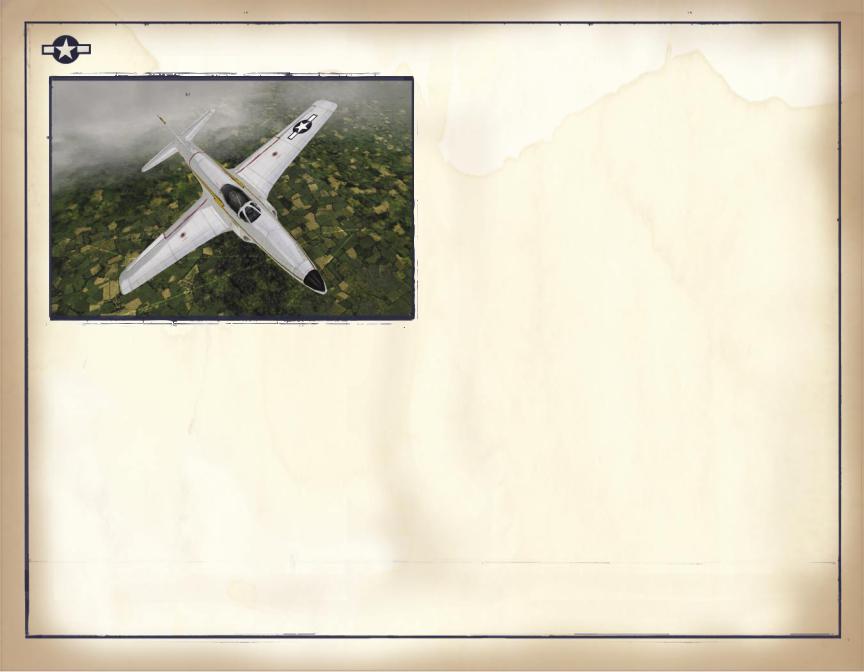
Subject: U.S. AIRCRAFT
Lockheed P-80A Shooting Star
P-80A
P-80A SPECIFICATIONS
WEIGHT: 7,920/14,000 lb. (3,600/6,364 kg)
SPAN: 38' 10.5" (11.84 m) LENGTH: 34' 6" (10.5 m)
ENGINE: One General Electric J-33-GE-9 turbojet with 3,850-lb. thrust
ARMAMENT: Six 0.5-in. Browning machine guns with 300 r.p.g., plus two 500-lb. or 1,000-lb. bombs or (on F-80C) ten 5-in. rockets
MAX SPEED @ ALTITUDE: 558 mph (898 km/h) @ sea level; 533 mph (858 km/h) @ 20,000 ft (6,096 m)
CEILING: 45,000 ft (13,716 m)
INITIAL CLIMB RATE: 4,166 ft/min (1,270 m/min)
RANGE: 780 mi (1,255 km); 1,100 mi (1,770 km) with two 165-gal. drop tanks
* * *
First flown as a prototype in January 1944, the P-80 became the first jet aircraft adopted for service by the USAAF, but production models became available just weeks too late to serve in WWII. The
Shooting Star was another brainchild of the Lockheed design team headed by Clarence “Kelly” Johnson, whose work also included the exotic P-38 Lightning and the SR-71 “Blackbird.” Its clean design, relatively powerful turbojet engine, and thin unswept laminar-flow wing made the P-80 an excellent performer for the time. Its speed, maneuverability, and armament qualified it as both an excellent fighter and fighter-bomber. The Shooting Star development project took an unexpected toll on August
6, 1945--the day the atom bomb was dropped on Hiroshima. Richard Bong, America’s top-scoring WWII ace, died on a test flight in California when his P-80 flamed out and stalled on takeoff.
* * *
STRENGTHS
-High speed.
-Excellent climb and maneuverability.
-Well-armed gunfighter can also deliver ordnance.
-Nose-mounted guns concentrate firepower and decrease convergence errors.
WEAKNESSES
-Slow engine spool-up and acceleration.
-Poor engine reliability.
- 7 -
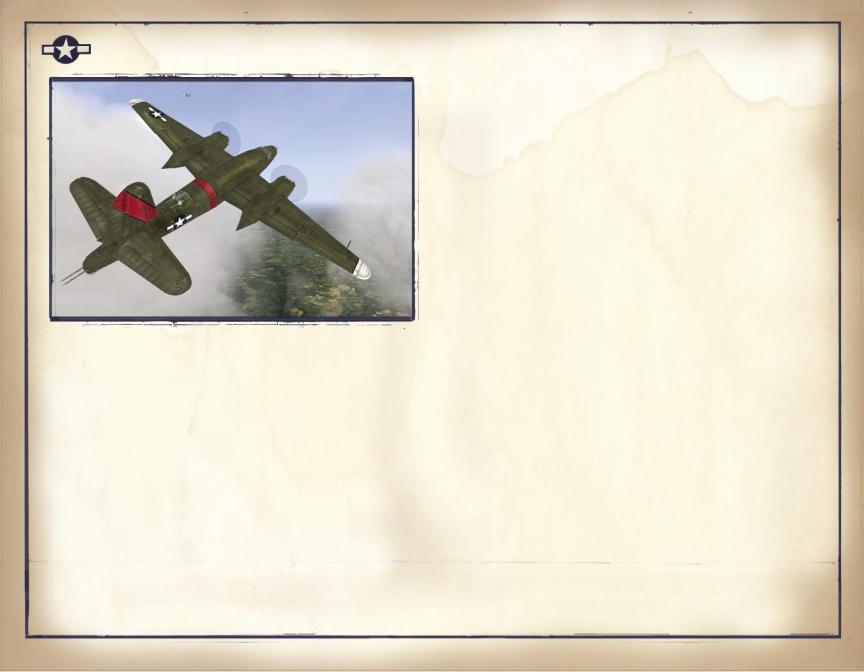
Subject: U.S. AIRCRAFT
Martin B-26C & B-26G Marauder
The Marauder’s greatest success as a workhorse B-26 of the U.S. Ninth Air Force came in the tactical air
support role before, during, and after the Allied invasion of Europe in 1944. Heavy armament and a big bomb load made the B-26 devastatingly effective in this role. Its highly loaded wing made the Marauder a “hot” plane with a high landing speed, a characteristic that cost some early crews their lives. Wing and fin modifications, and an aggressive training program, decreased operational accidents and helped get the best out of this capable aircraft. The C model increased the wing’s span by six feet; the later F and G models increased the wing’s angle of incidence by 3.5 degrees to shorten takeoff distance and decrease landing speed. By the end of the war, the B-26 had the lowest loss rate of all of the American bombers in the European Theater.
- 8 -
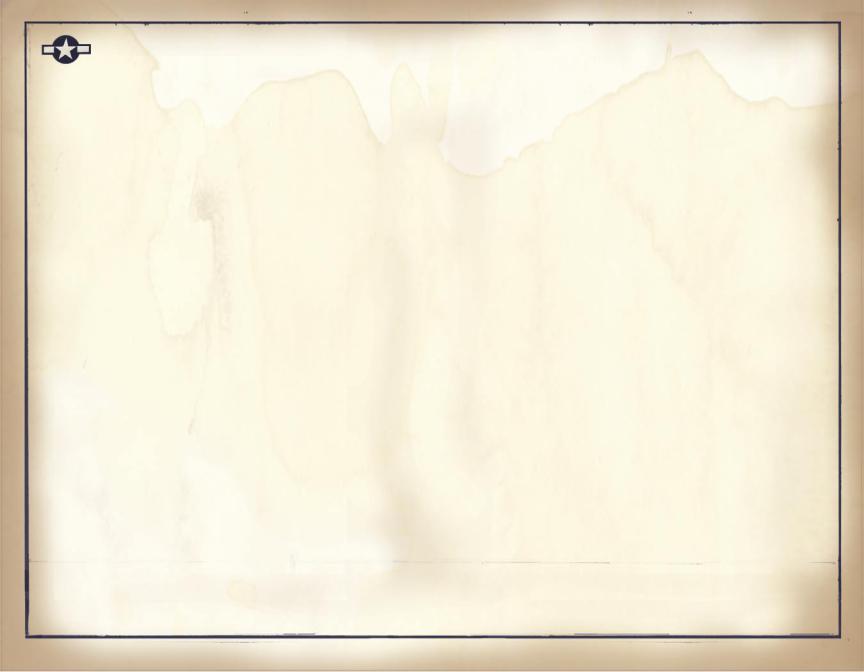
Subject: U.S. AIRCRAFT
B-26C SPECIFICATIONS
WEIGHT: 23,800/38,200 lb. (10,818/17,363 kg) SPAN: 71' (21.6 m) LENGTH: 56' 1" (17 m)
ENGINE: Two Pratt & Whitney R-2800-43 18-cyl. aircooled radials with 2,000 hp each
ARMAMENT: Twelve 0.5-in. Browning machine guns-- one flexible and one fixed gun in the nose (fixed gun later omitted), four fixed-package guns on the sides, two in the top turret, two in the lower waist, and two in the tail--plus 3,000 lb. of bombs. Optional: Fourteen 5-in. rockets
MAX SPEED @ ALTITUDE: 283 mph (455 km/h) @ 5,000 ft (1,524 m)
CEILING: 19,800 ft (6,035 m)
INITIAL CLIMB RATE: 1000 ft/min (305 m/min) RANGE: 1,150 mi (1,850 km)
* * *
B-26G SPECIFICATIONS
WEIGHT: 23,800/38,200 lb. (10,818/17,363 kg) SPAN: 71' (21.6 m) LENGTH: 56' 1" (17 m)
ENGINE: Two Pratt & Whitney R-2800-43 18-cyl. air-cooled radials with 2,000 hp each
ARMAMENT: Twelve 0.5-in. Browning machine guns (as above, but without fixed nose gun), plus 4,000-lb. of bombs Optional: Fourteen 5-in. rockets
MAX SPEED @ ALTITUDE: 283 mph (455 km/h) @ 5,000 ft (1,524 m)
CEILING: 19,800 ft (6,035 m)
INITIAL CLIMB RATE: 1000 ft/min (305 m/min) RANGE: 1,150 mi (1,850 km)
* * *
STRENGTHS (ALL B-26 VARIANTS)
-High-speed cruise.
-Heavy armament and bomb load.
WEAKNESSES (ALL B-26 VARIANTS)
-High landing speed dangerous for unwary pilots.
-Vulnerable to fighters, requires escort.
- 9 -
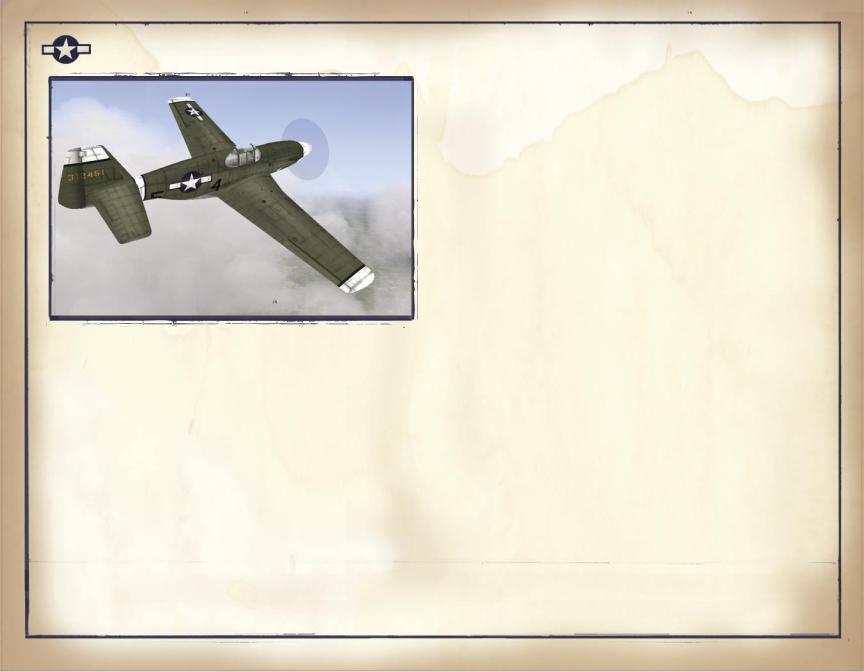
Subject: U.S. AIRCRAFT
North American P-51B and P-51D Mustang
Once the Mustang got Rolls-Royce Merlin power P-51B in the P-51B, it excelled in every role, including tactical fighter-bomber. The bubble canopy of the D model added superior visibility. Fast and agile as an interceptor, the P-51 gave Allied forces excel-
lent tactical support in the ground attack role. Its heavy gun armament, combined with bombs and rockets, helped the Ninth Air Force suppress enemy ground forces and transport, speeding the advance of Patton’s Third Army across France and into Germany. The Mustang’s only flaw as a fighter-bomber was its liquid-cooled engine, a liability it shared with other front-line aircraft, including the Spitfire, Typhoon, Tempest, and Bf 109. A piece of flak or a small-arms round in the coolant system could turn this otherwise potent attack aircraft into a very short-range glider.
- 10 -
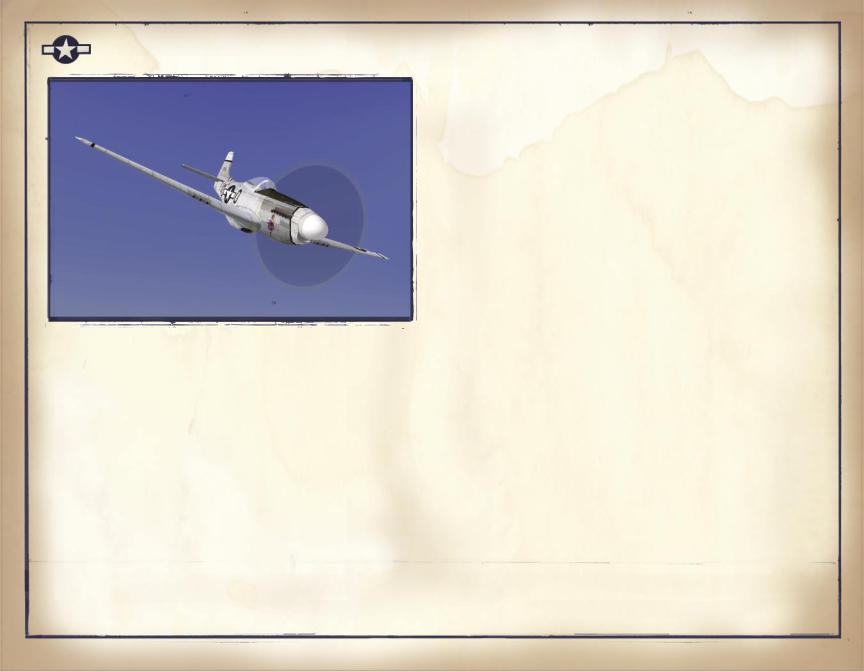
Subject: U.S. AIRCRAFT
P-51D |
P-51D SPECIFICATIONS |
|
WEIGHT: 7,125/11,600 lb. (3,230/5,206 kg) |
||
|
||
|
SPAN: 37' 0.25" (11.29 m) LENGTH: 32' 2.5" (9.81 m) |
|
|
ENGINE: One Rolls-Royce/ Packard V-1650-7 liquid- |
|
|
cooled V-12 with 1,490 hp |
|
|
ARMAMENT: Six 0.5-in. Browning machine guns with |
|
|
270 r.p.g. (outboard & center pairs) & 400 r.p.g. |
|
|
(inboard pair), plus two 500-lb. or 1000-lb. bombs |
|
|
or six 5-in. rockets |
|
|
MAX SPEED @ ALTITUDE: 437 mph (703 km/h) @ 25,000 ft |
|
|
(9,144 m) |
|
|
CEILING: 41,900 ft (12,780 m) |
|
|
INITIAL CLIMB RATE: 3,125 ft/min (952 m/min) |
|
|
RANGE: 1,300 mi (2,092 km); 2,080 mi (3,347 km) with |
|
|
drop tanks |
|
|
* * * |
P-51B SPECIFICATIONS
WEIGHT: 7,125/11,600 lb. (3,230/5,206 kg)
SPAN: 37' 0.25" (11.29 m) LENGTH: 32' 2.5" (9.81 m)
ENGINE: One Rolls-Royce/Packard V-1650-3 liquidcooled V-12 with 1,380 hp
ARMAMENT: Four 0.5-in. Browning machine guns with 400 r.p.g., plus two 500-lb. or 1000-lb. bombs
MAX SPEED @ ALTITUDE: 440 mph (708 km/h) @ 30,000 ft (7,620 m)
CEILING: 41,800 ft (12,740 m)
INITIAL CLIMB RATE: 2,780 ft/min (847 m/min)
RANGE: 1,300 mi (2,092 km); 2,080 mi (3,347 km) with drop tanks
* * *
STRENGTHS (ALL P-51 VARIANTS)
-Excellent acceleration, speed, handling, and maneuverability.
-Enormous range.
-Heavy firepower from six .50-inch guns.
-Excellent pilot visibility.
WEAKNESSES (ALL P-51 VARIANTS)
-Very sensitive to sudden throttle application, which can cause severe swing or rollover and crash on takeoff.
-Treacherous handling with aft fuselage tank full.
-Liquid cooling increases engine vulnerability to damage from flak and small arms fire.
- 11 -
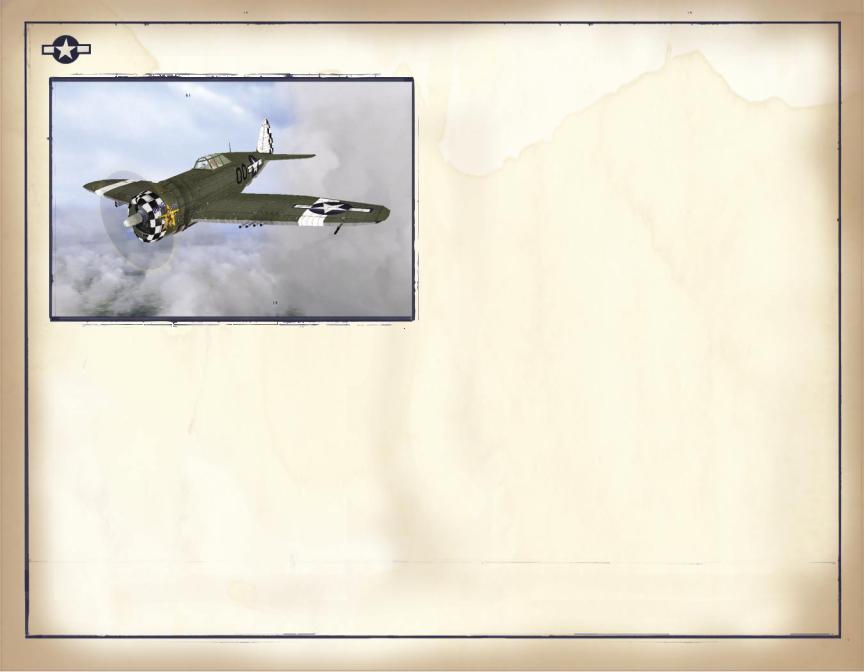
Subject: U.S. AIRCRAFT
Republic P-47D (early models) & P-47D-25 Thunderbolt
The biggest, heaviest fighter of the war, the P-47D Thunderbolt was also the most successful American fighter-bomber of WWII. Nicknamed the “Jug” either
because it resembled a squat milk jug or as an abbreviation of “Juggernaut,” it was ruggedly built and powered by a massive and durable air-cooled radial engine. The Thunderbolt could absorb damage that would knock other fighters down and still keep flying. It was also easy to fly with light stick forces, and very forgiving. Commencing with the P- 47D-25 production block, the ungainly “Jug” became more sleek and provided better visibility with its bubble canopy and slimmed-down aft fuselage. U.S. Ninth Air Force Thunderbolts joined British Typhoons and Tempests as a devastating tactical air support weapon. It combined high performance with heavy firepower and a big ordnance load to become the American aircraft of choice in the ground attack role.
- 12 -
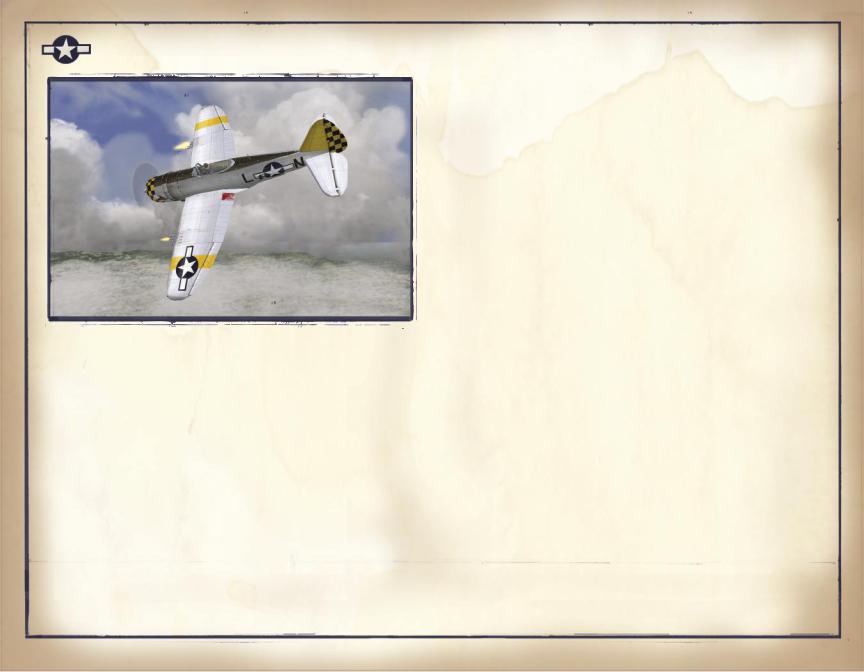
Subject: U.S. AIRCRAFT
P-47D-25
P-47D SPECIFICATIONS
(Early models) WEIGHT: 9,900/14,925 lb. (4,500/6,784 kg)
SPAN: 40' 9.25" (12.4 m) LENGTH: 36' 1.25" (11.03 m)
ENGINE: One Pratt & Whitney R-2800-21 Double Wasp 18-cyl. air-cooled radial with 2,000 hp
ARMAMENT: Eight 0.5-in. Browning machine guns with 267 or 425 r.p.g., plus two 1000-lb. or three 500-lb. bombs or ten 5-in. rockets
MAX SPEED @ ALTITUDE: 428 mph (689 km/h) @ 30,000 ft (9,150 m)
P-47D-25 SPECIFICATIONS
WEIGHT: 10,300/19,400 lb. (4,545/8.818 kg)
SPAN: 40' 9.25" (12.4 m) LENGTH: 36' 1.25" (11.03 m)
ENGINE: One Pratt & Whitney R-2800-59 Double Wasp 18-cyl. air-cooled radial with 2,000 hp (2,300 hp with water injection for war emergency power)
ARMAMENT: Eight 0.5-in. Browning machine guns with 267 or 425 r.p.g., plus two 1000-lb. or three 500-lb. bombs or ten 5-in. rockets
MAX SPEED @ ALTITUDE: 428 mph (689 km/h) @ 30,000 ft (9,150 m)
CEILING: 42,000 ft (12,810 m)
INITIAL CLIMB RATE: 3,120 ft/min (950 m/min)
RANGE: 1,000 mi (1,610 km); 1,900 mi (3,057 km) with drop tanks
* * *
STRENGTHS (ALL P-47 VARIANTS)
-Fast, stable, easy to fly, forgiving; a confidencebuilder for novice pilots.
-Impressive roll rate.
-Nothing outdives a Jug.
-Extremely rugged construction.
-Massive firepower from eight 0.5-in. guns.
-Heavy ordnance load.
-Bubble canopy provides excellent visibility.
-Air-cooled radial engine shields pilot and can sustain major damage yet keep running.
CEILING: 42,000 ft (12,810 m)
INITIAL CLIMB RATE: 3,120 ft/min (950 m/min)
RANGE: 1,000 mi (1,610 km); 1,900 mi (3,057 km) with drop tanks
* * *
WEAKNESSES (ALL P-47 VARIANTS)
-Tends to “mush” in a dive, losing altitude rapidly; pull out in time or dig a big hole.
-Not as maneuverable as smaller, lighter fighters.
-Mediocre turn radius and rate.
-Poor zoom climb; loses energy rapidly.
- 13 -
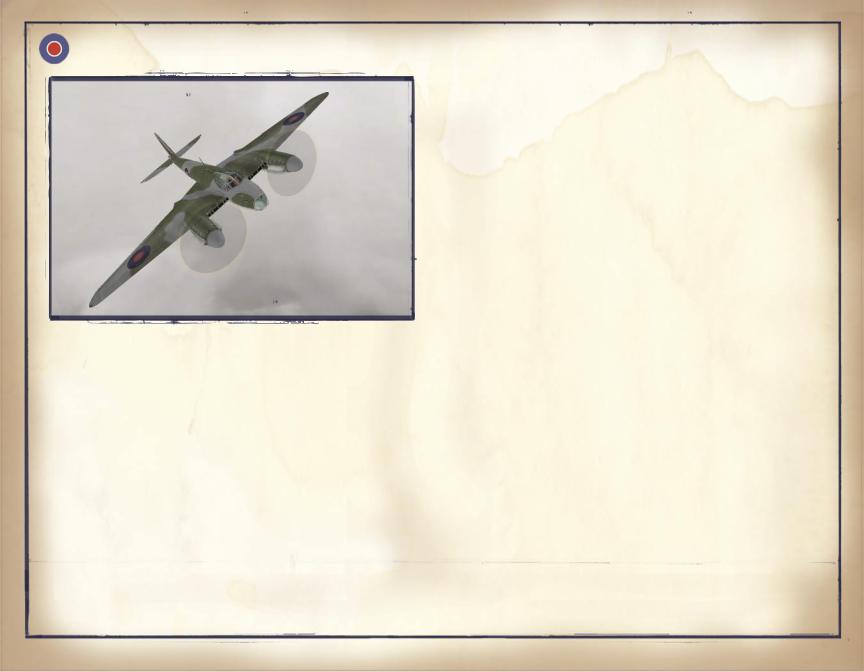
|
Subject: BRITISH AIRCRAFT |
|
de Havilland Mosquito B. IV, F.B. VI, and F.B. XVIII |
Mosquito |
Affectionately known as the “Wooden Wonder” |
or the “Mossie,” the fast and versatile Mosquito |
|
|
served first as a light, unarmed bomber, and then |
|
as Britain’s most successful night fighter. In mid- |
|
1943 its most numerous variant, the F.B. VI fighter- |
|
bomber, appeared. Designed from the start to use |
|
nonstrategic materials, its molded plywood construc- |
|
tion made the Mosquito light and strong. Its twin |
|
Merlin V-12s gave it sufficient speed to outrun |
|
most fighters at low to medium altitudes, and its |
|
heavy armament and bomb load made it a formidable |
|
fighter-bomber. The F.B. XVIII, a variant of the |
|
F.B. VI, was armed with a 57-mm antitank cannon. |
|
Its bigger bite earned it the nickname “Tse Tse.” |
|
The RAF’s Second Tactical Air Force demonstrated |
|
the Mosquito’s effectiveness against ground targets, |
|
while Coastal Command showed what its guns and |
|
rocket salvos could do against enemy shipping. |
- 14 -

Subject: BRITISH AIRCRAFT
MOSQUITO B. IV SPECIFICATIONS
WEIGHT: 14,100/22,500 lb. (6,409/10,227 kg) SPAN: 54' 2" (16.5 m) LENGTH: 40' 9" (12.4 m)
ENGINE: Two Rolls-Royce Merlin 21 liquid-cooled V-12s with 1,230 hp each
ARMAMENT: No defensive armament; 2,000-lb. of bombs (four 500-lb. bombs in internal bomb bay)
MAX SPEED @ ALTITUDE: 380 mph (611 km/h) @ 17,000 ft (5,182 m)
CEILING: 28,800 ft (8,778 m)
INITIAL CLIMB RATE: 1,700 ft/min (518 m/min) RANGE: 1,860 mi (2,992 km) with maximum bomb load
* * *
MOSQUITO F.B. VI SPECIFICATIONS
WEIGHT: 14,100/22,500 lb. (6,409/10,227 kg) SPAN: 54' 2" (16.5 m) LENGTH: 40' 6" (12.3 m)
ENGINE: Two Rolls-Royce Merlin 25 liquid-cooled V-12s with 1,635 hp each
ARMAMENT: Four 20-mm Hispano cannon in belly under nose with 150 r.p.g., plus four 0.303-in. Browning machine guns on nose with 500 r.p.g., plus 2,000 lb. of bombs (in fuselage & under wings) or 1,000 lb. of bombs and eight 60-lb. rocket projectiles
MAX SPEED @ ALTITUDE: 380 mph (611 km/h) @ 13,000 ft (3,962 m)
CEILING: 36,000 ft (10,973 m)
INITIAL CLIMB RATE: 1,870 ft/min (570 m/min)
RANGE: 1,205 mi (1,938 km) with internal fuel; 1,705 mi (2,743 km) with full load and auxiliary tanks
MOSQUITO F.B. XVIII SPECIFICATIONS
WEIGHT: 14,100/22,500 lb. (6,409/10,227 kg) SPAN: 54' 2" (16.5 m) LENGTH: 40' 6" (12.3 m)
ENGINE: Two Rolls-Royce Merlin 25 liquid-cooled V-12s with 1,635 hp each
ARMAMENT: Four .303-in. Browning machine guns on nose with 500 r.p.g., plus one 57-mm Molins cannon with 25 rounds, plus 1,000 lb. of bombs and eight 60-lb. rocket projectiles
MAX SPEED @ ALTITUDE: 380 mph (611 km/h) @ 13,000 ft (3,962 m)
CEILING: 36,000 ft (10,973 m)
INITIAL CLIMB RATE: 1,870 ft/min (570 m/min)
RANGE: 1,205 mi (1,938 km) with internal fuel; 1,705 mi (2,743 km) with full load and auxiliary tanks
* * *
STRENGTHS (ALL VARIANTS)
-High speed, especially at lower altititudes.
-Heavy armament.
WEAKNESSES (ALL VARIANTS)
-Not as rugged as stressed aluminum aircraft.
-Easy for enemy pilots to identify.
* * *
- 15 -
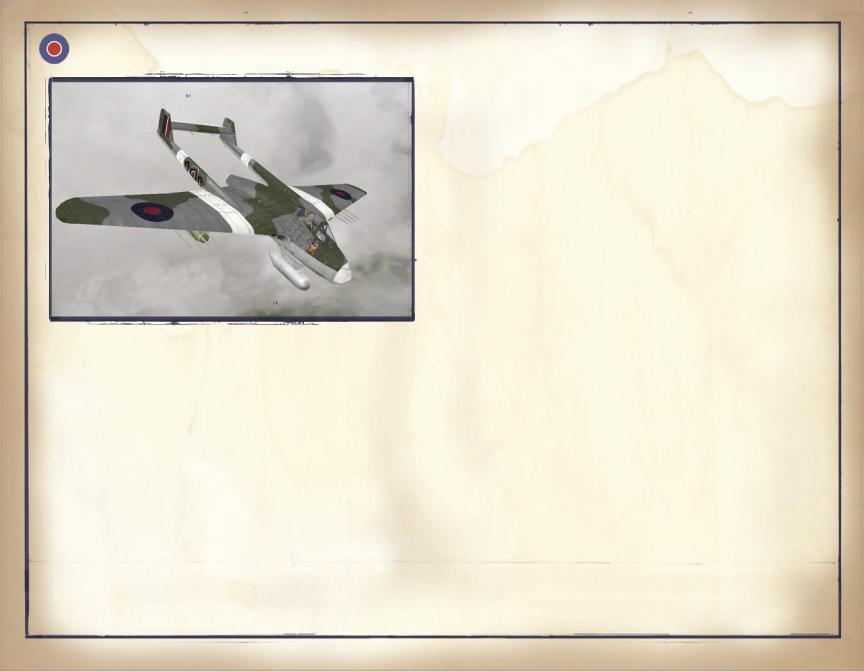
Subject: BRITISH AIRCRAFT
de Havilland Vampire F.1
Vampire
VAMPIRE F.1 SPECIFICATIONS
WEIGHT: 6,372/10,480 lb. (2,896/4,764 kg) SPAN: 40' (12.2 m) LENGTH: 30' 9" (9.4 m)
ENGINE: One de Havilland Goblin II turbojet with 3,100-lb. thrust
ARMAMENT: Four 20-mm Hispano cannon with 150 r.p.g.
MAX SPEED @ ALTITUDE: 540 mph (869 km/h) @ 20,000 ft (6,096 m)
CEILING: 42,800 ft (13,045 m)
INITIAL CLIMB RATE: 4,200 ft/min (1,280 m/min) RANGE: 730 mi (1,175 km)
* * *
The Vampire (Britain’s second jet fighter after the Gloster Meteor) was just months too late for service in WWII; the first production aircraft took to the air in April 1945. Its single-engine, twinboom design made it the first Allied jet to match the performance of the German Messerschmitt 262. The Vampire served first as a high-speed interceptor, and later (under the designation F.B. 5) as a close support fighter-bomber carrying 2,000 pounds of bombs or rockets. It is tantalizing to imagine how encounters between the Vampire and the German jet fighters might have gone. Do well enough in conventional aircraft, and you may earn the opportunity to find out firsthand.
* * *
STRENGTHS
-Fast and maneuverable.
-Four 20-mm cannon deliver a massive punch.
WEAKNESSES
-Leisurely acceleration.
-Short engine life.
- 16 -

Subject: BRITISH AIRCRAFT
Hawker Typhoon IB
Typhoon
TYPHOON IB SPECIFICATIONS
WEIGHT: 8,800/11,400 lb. (4,000/5,182 kg) SPAN: 41' 7" (12.7 m) LENGTH: 31' 10" (9.7 m)
ENGINE: One Napier Sabre IIA 24-cyl. liquid-cooled flat-H with 2,180 hp
ARMAMENT: Four 20-mm Hispano cannon with 140 r.p.g., plus two 1,000-lb. bombs or eight 60-lb. rocket projectiles
MAX SPEED @ ALTITUDE: 405 mph (652 km/h) @ 18,000 ft (5,486 m)
CEILING: 34,000 ft (10,363 m)
INITIAL CLIMB RATE: 2,540 ft/min (774 m/min)
RANGE: 510 mi (820 km) with bombs; 980 mi (1,577 km) without bombs and with drop tanks
* * *
The Typhoon was Hawker’s successor to the aging Hurricane. Its big, ambitious design was based on the massive 36-liter Napier Sabre flat-H engine. While the complex and maintenance-intensive Sabre never provided outstanding reliability, it did provide well over 2,000 horsepower, which gave the Typhoon far greater performance than anything imagined when the Hurricane was new. The Typhoon was rushed into service late in 1941, but some serious shortcomings prevented it from fulfilling its intended role of interceptor. Its thick wing made for instability at high altitudes, and its poorly designed aft fuselage caused the tail to break away during fast, steep dives. By late 1942 its structural problems were worked out, and the Typhoon came into its own as a powerful and heavily armed lowlevel fighter-bomber. After the Normandy invasion, Typhoons of the Second Tactical Air Force destroyed concentrations of German armor and made the roads of France and Belgium unsafe for enemy troops or transport.
* * *
STRENGTHS
-High speed.
-Heavy armament and ordnance load.
WEAKNESSES
-Poor handling and performance above 20,000 feet.
-For its power, a relatively leisurely rate of climb.
-Poor engine reliability.
- 17 -
